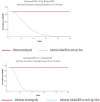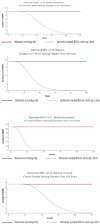The Cost-Effectiveness of Quadrivalent Human Papillomavirus Vaccination in Indonesia
- PMID: 28749644
- PMCID: PMC5648413
- DOI: 10.22034/APJCP.2017.18.7.2011
The Cost-Effectiveness of Quadrivalent Human Papillomavirus Vaccination in Indonesia
Abstract
Objective: National cervical cancer prevention program has been initiated in Indonesia since April 2015 and the ministry of health has started efforts to integrate the HPV Vaccine in the national immunization program since Q4 2015. Thus, it becomes important to analyze the cost-effectiveness of HPV vaccine. The objective of this model is to examine the potential long-term epidemiologic and economic impact of quadrivalent HPV(qHPV;6/11/16/18) vaccination program in Indonesia. Methods: A previously validated transmission dynamic model was used to estimate the long-term epidemiologic and economic consequences of quadrivalent HPV vaccination by comparing cost-effectiveness of 2 dose qHPV vaccination strategy for girls 11-12 years old (with or without catch up; catch up dose for 12–26 years) versus Screening Only (Pap Smear) for reducing cost related to HPV type 6,11,16,18 (cervical cancer, CIN 1, CIN 2/3, and genital warts). Costs of an HPV disease episode-of-care (diagnosis and treatment) were calculated for base case analysis using local Indonesian cost. Result: 2-dose qHPV vaccination strategies without catch up reduce the overall incidence of HPV 16/18–related cervical cancer relative to screening by 54.4% over the 100 year following vaccine introduction. Likewise, vaccination strategies reduce the incidence of HPV type 16/18 CIN 2/3, CIN 1 by 69.1% and 71.8% respectively, also reducing HPV type 6/11 CIN 1, genital warts in female, genital warts in male by 82.9%,84.2%,82.1% respectively, at this time point. From total reduction of health care cost, 67.1% attributable for diseases caused by HPV type 16/18 and 32.9% attributable for diseases caused by HPV type 6/11. Without catch up, cost/QALY would be $450/year. However catch-up strategy is more cost effective versus vaccinates 12-year-old girls only; with cost/QALYs would be $390/year. Conclusion: HPV 6/11/16/18 vaccination of females in Indonesia are 1) substantially reduce genital warts, CIN, and cervical cancer; 2) improve quality of life, and 3) with the Indonesia GDP of USD 3,531.80 in 2014 , Cost/QALYs result with or without catch up is considered very cost-effective when implemented; however with catch up, the cost/QALY can be better.
Keywords: Cervical cancer; prevention; quadrivalent HPV vaccine; cost-effectiveness; Indonesia.
Creative Commons Attribution License
Figures



References
-
- Ali H, et al. Genital warts in young Australians five years into national human papillomavirus vaccination programme: national surveillance data. BMJ. 2013;346:2032. - PubMed
-
- Bruni L, Barrionuevo-Rosas L, Albero G, et al. ICO information centre on HPV and cancer (HPV information centre) Human papillomavirus and related diseases in Indonesia. 2014. Version posted on www.hpvcentre.net. in August 22nd, 2014.
-
- Clifford GM, Gallus S, Herrero R, et al. Worldwide distribution of human papillomavirus types in cytologically normal women in the International Agency for Research on Cancer HPV prevalence surveys: a pooled analysis. Lancet. 2005;366:991–8. - PubMed
-
- Carter JJ, Madeleine MM, Shera K, et al. Human papillomavirus 16 and 18 L1 serology compared across anogenital cancer sites. Cancer Res. 2001;61:1934–40. - PubMed
LinkOut - more resources
Full Text Sources
Research Materials
Miscellaneous

